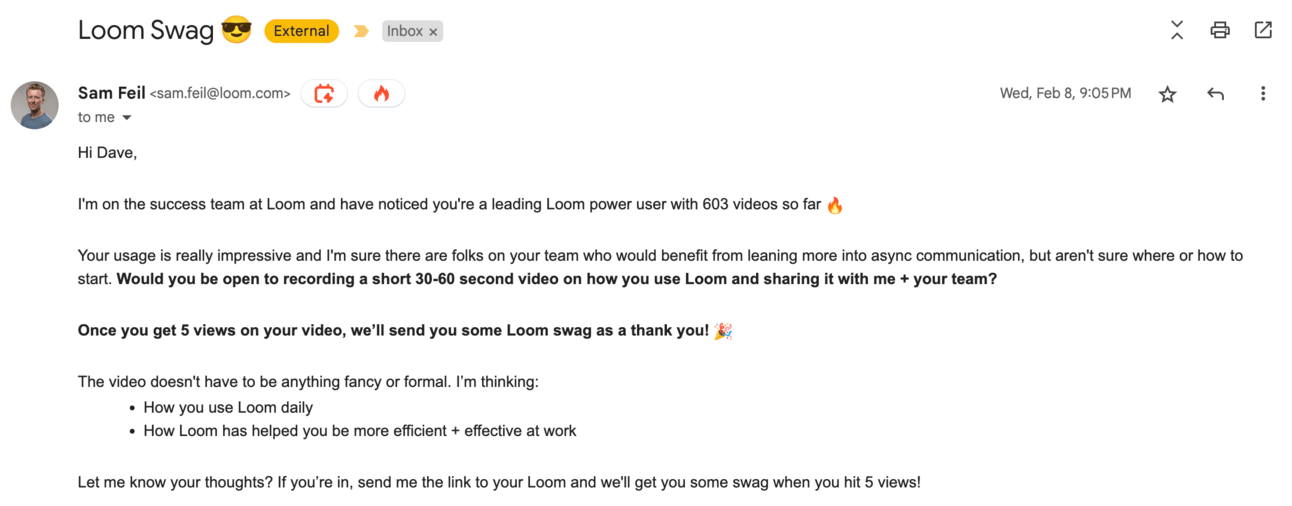Last week, Atlassian announced its plan to acquire video messaging startup Loom for $975 million. Loom was previously valued at $1.5 billion. The former unicorn joins Atlassian to create the future of work communication, aimed primarily at enterprise organizations.
Whenever a startup gets acquired like this, it’s a significant moment for the cofounders, investors, and hopefully, the employees: this is the moment they’ve all been waiting for - when their wealth “on paper” becomes liquid wealth in their pockets. Surprisingly, Atlassian says it plans to pay for the acquisition with cash on hand. Imagine having $975 million in your checking account!
It’s unclear if everybody wins from this deal or not, but nevertheless, an exit is a major milestone and a huge achievement for any startup — one that comes with lessons for entrepreneurs for their own journeys.
Welcome to Dave’s Deep Dives. I write a weekly research report in Entrepreneur’s Handbook where I get personally obsessed with a company, a founder, or an idea and hunt for the deeper insights and best takeaways to share with you. Subscribe to receive them on Thursdays.
4 Lessons from Loom’s Exit
1. Loom’s early days are proof that if your startup isn’t gaining traction, take stock and reset. You might be 1-2 pivots away from becoming a unicorn. Keep going.

The early version of Loom was called “Opentest” and it struggled.
The three cofounders spent eight months hounding people to use the original version of Loom. The product went through various failed launches and fundraising attempts due to little traction.
There was no secret sauce, no secret growth hack, and no novel “key insight” that led Loom to product-market fit. It was an arduous grind of feverishly listening to user feedback, making pivots, and late nights.
But instead of giving up, they maxed out their credit cards and kept going. They widened the problem they were solving. They evolved from a “video tool for gathering expert feedback” to focus on a much bigger market: video’s role in work communication. This much bigger problem turned out to be the raison d'être that they rode to an Atlassian exit.
Did you know? Loom launched 14 times on Product Hunt.
2. Loom CEO Joe Thomas on the two types of positioning statements for your product and why it’s critical to know which one to use first.
In a 2020 interview with Jason Calacanis on This Week In Startups, Joe Thomas explained the differences in how they pitched Loom over time: he described it as utilitarian vs. aspirational.
“For early-stage companies building out their marketing, when you’re working on creating a new behavior, you have to be very utilitarian and direct about what [your product] is and what it does functionally as a software.”
For example, in the early days, Thomas described the product in a more utilitarian way as “a screen recorder that layers on your camera bubble and audio and makes it instantaneous for you to share videos.”
Four years later, once people became more familiar with the concept of using video at work, “you can go more aspirational from a marketing perspective,” said Thomas. “So that’s where we started to get into video messaging. It’s more expressive. It’s more efficient. It’s less functional in our marketing and more aspirational in nature.”
Take a look at your marketing. Depending on how early-stage you are, you may not want to be too aspirational with your product positioning and might benefit by taking a more utilitarian approach.
3. Loom sent its power users hundreds of dollars of swag in one of the smartest growth campaigns I’ve seen.
Back in February this year, I received this email from Loom:

Email from Loom
Because I made 603 videos with Loom, they reached out to me as a “power user.”
So they asked me to create a video (using Loom, of course) on how I use Loom daily and how it makes me more efficient and effective at work and to share it with them and my team. If the video received 5 views, they’d send me the swag.
Do you see the genius here? They identified their power users (high product usage), leveraged PLG (record with Loom) for virality (5 views from other team members) within their target market (enterprise teams) and rewarded them with swag (longtail community marketing).
And their swag wasn’t cheap. It was chic, comfortable, and high quality. It felt as if they partnered with L.L. Bean to create a clothing brand. I wear it all the time.

From a comment on Linkedin
FWIW, the items included:
A baseball cap
A sailors hat
A sweatshirt
A long sleeve
Two t-shirts
A magazine
A candle
A tote bag
4. How Loom’s org structure is designed for product-led growth
The typical tech company org chart divides up into the following groups:
GTM (Go-To-Market) - marketing, sales, customer success, support
EPD - engineering, product, and design
G&A (General & Administrative) - finance, accounting, human resources, legal, procurement, IT, and operations
But Loom’s org chart is different. Loom COO Anique Dumright described it on FirstRound Capital’s podcast “In Depth.” It looks like this:
Engineering
Product, Marketing, Design, Operations, Data
Sales, Success/Support
People, Finance
The biggest difference is that Marketing (typically sits in GTM), Operations and Data (both typically sit in G&A) and Product and Design (both typically sit in EPD) are all in the same organization.
“At a PLG business, marketing, product, design, and data are so interdependent, so we bring them together and gain a lot of efficiency and focus as a more cross-functional team,” said Dumright.
Merging these teams together synergizes a more natural alignment around product-led growth. More startups should really consider doing this.
What do you think? - Hit reply and let me know.
Thanks for reading. See you next Thursday.
Dave

